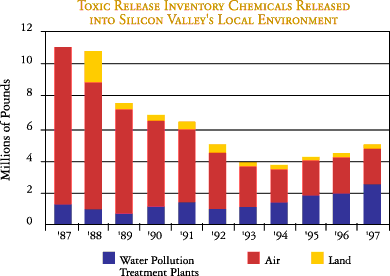
Toxic Chemical Releases Edge Upward After Years of Decline
Why Is This Important?
More than 3,000 facilities in Silicon Valley generate hazardous waste. Releases of toxic chemicals into our air, land, water, or sewage systems can cause public health and environmental hazards. Approximately 141 manufacturing facilities in Silicon Valley are required by law to report releases of certain toxic chemicals to the U.S. Environmental Protection Agency under the Toxic Release Inventory law.

How Are We Doing?
Silicon Valley manufacturers subject to Toxic Release Inventory reporting achieved a 55 % reduction in the amount of toxic chemicals released into our local environment between 1987 and 1997. However, total releases have increased 32% since 1994, primarily from increased discharges to water pollution control plants. About one-third of the increase since 1994 is attributable to expanded reporting requirements, while the other two-thirds may be due to increased economic activity. The primary reason for the large reduction in releases from 1987 to 1994 is a decrease in air emissions, particularly ozone-depleting compounds.
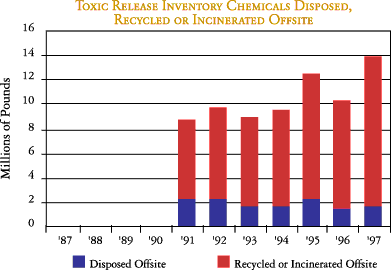
Data Source: U.S. Environmental Protection Agency
In addition to the 4.9 million pounds of Toxic Release Inventory chemicals released to the local environment in 1997, 12.2 million pounds were recycled or incinerated offsite, and about 1.6 million pounds were disposed offsite. Santa Clara County ranks 10th among California's 58 counties for total pollution reported under the Toxic Release Inventory law.
Why Is This Important?
Pesticides applied to homes, gardens, buildings, agriculture, rights-of-way, and other places run off into our waterways, polluting water and threatening the health of wildlife. Organic food production (growing at 20 percent per year) and non-toxic pest management are emerging as alternatives to toxic pesticide use.
How Are We Doing?
The majority of toxic pesticides used in Santa Clara County during 1997 (excluding residential use) was for agriculture. The following five pesticides account for almost three-fourths of the most toxic pesticides used in 1997: methyl bromide, diazinon, metam-sodium, chlorpyrifos, and diuron.
Why Is This Important?
How Are We Doing?
Another important source of hazardous wastes
(not included in the graph) is hazardous wastes
generated by households, such as old paint,
pesticides, and batteries.
Website developed by Clary Meuser Research Associates
![]()
Use of Most Toxic Pesticides Drops 51% in 6 Years (Excluding Residential Use)
Widespread use of toxic pesticides can damage human health and the environment. The most toxic pesticides can cause cancer, pose reproductive hazards, disrupt hormone function, are nerve toxins, and/or pollute the air and water.
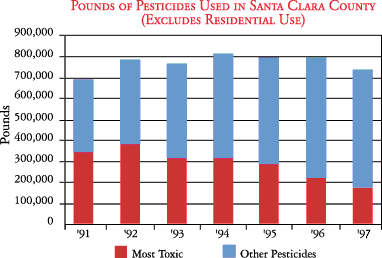
Of the 740,533 pounds of pesticides applied in Santa Clara County during 1997 (excluding residential use) almost one-quarter is classified as most toxic. While total use of pesticides in Santa Clara County increased 6% from 1991 to 1997, use of the most toxic chemicals dropped 51% during the same timeframe. The decline in the use of most toxic pesticides is driven by sharp decreases in the use of methyl bromide (primarily used in agriculture) and chlorpyrifos (primarily used in structural pest control in Santa Clara County). However, these decreases were somewhat offset by an increase in the use of metam-sodium in agriculture and rights-of-way.
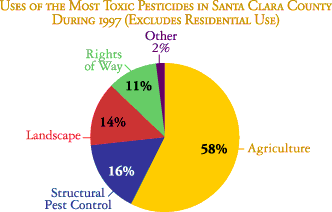
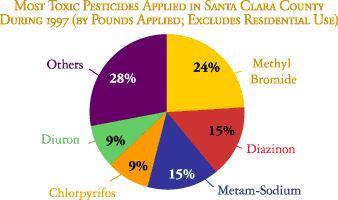
Data Source: California Department
of Pesticide Regulation
![]()
Hazardous Waste Generation Increases
Inadequate control of hazardous waste can result in substantial risks to human health and the environment. Hazardous waste disposed to land or improperly managed may lead to risk of an increase in mortality or illness, and can pose a hazard to human health and the environment. Open dumping, spills, and leaks may be particularly harmful to health, contaminate drinking water, and pollute the land and air.
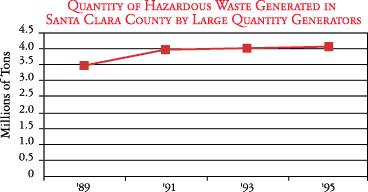
Data Source: Biennial Reporting System, Center for Environmental
Information and Statistics, U.S. Environmental Protection Agency
Total tons of hazardous waste generated by Santa Clara County's large quantity generators increased from 3.4 million tons in 1989 to 4.1 tons in 1995, an 18% increase. These hazardous wastes were recycled, treated, or disposed.
Copyright � 1999, Silicon Valley Environmental Partnership
All Rights Reserved